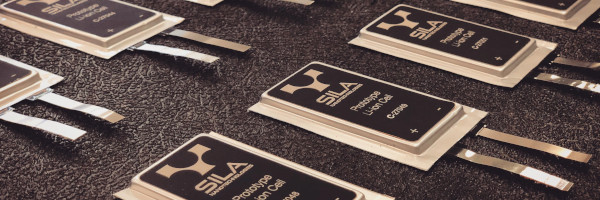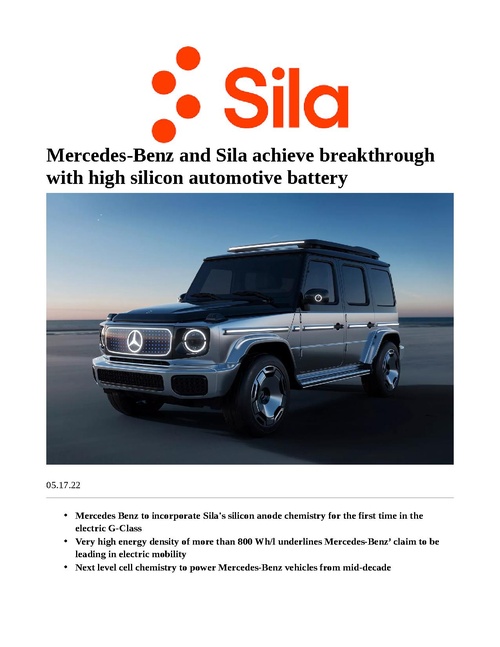Mercedes-Benz and Sila battery breakthrough: Difference between revisions
Created page with "{{News |Published=2022-05-07 |Organization=Daimler, Sila |Where=Stuttgart Germany |Summary=Mercedes-Benz takes another major step in building the world’s most desirable elec..." |
No edit summary |
||
| Line 1: | Line 1: | ||
{{News | {{News | ||
|Image=Sila-nano-Cells3.jpg | |||
|Published=2022-05-07 | |Published=2022-05-07 | ||
|Organization=Daimler, Sila | |Organization=Daimler, Sila | ||
|poc=info@silanano.com | |||
|Where=Stuttgart Germany | |Where=Stuttgart Germany | ||
|Summary=Mercedes-Benz takes another major step in building the world’s most desirable electric cars. The inventor of the automobile today announced that it will work with Sila, a next-generation battery materials company, to incorporate Sila’s silicon anode chemistry in batteries which are optionally available for the first time in the upcoming electric Mercedes-Benz G-Class. This will add another innovative cell chemistry to the Mercedes-Benz battery portfolio. | |Summary=Mercedes-Benz takes another major step in building the world’s most desirable electric cars. The inventor of the automobile today announced that it will work with Sila, a next-generation battery materials company, to incorporate Sila’s silicon anode chemistry in batteries which are optionally available for the first time in the upcoming electric Mercedes-Benz G-Class. This will add another innovative cell chemistry to the Mercedes-Benz battery portfolio. | ||
Latest revision as of 18:11, June 28, 2022
| News | |
| Image | 
|
|---|---|
| Published | 2022-05-07 |
| Point(s) of Contact | info@silanano.com |
| Organization(s) | Daimler Sila |
| Where | Stuttgart Germany |
| Display | Yes |

| |
Mercedes-Benz takes another major step in building the world’s most desirable electric cars. The inventor of the automobile today announced that it will work with Sila, a next-generation battery materials company, to incorporate Sila’s silicon anode chemistry in batteries which are optionally available for the first time in the upcoming electric Mercedes-Benz G-Class. This will add another innovative cell chemistry to the Mercedes-Benz battery portfolio.
- Mercedes Benz to incorporate Sila's silicon anode chemistry for the first time in the electric G-Class
- Very high energy density of more than 800 Wh/l underlines Mercedes-Benz’ claim to be leading in electric mobility
- Next level cell chemistry to power Mercedes-Benz vehicles from mid-decade
The innovative high-silicon anode material will increase the energy density of batteries without compromising safety or other performance parameters. Compared to today’s commercially available cells with a comparable format, Sila’s technology enables a 20-40% increase in energy density reaching more than 800 Wh/l at cell level. This major development enables Mercedes-Benz to store much more energy in the same space, thus increasing range of its future vehicles by a significant amount.
The advanced silicon anode materials will be manufactured using 100% renewable energy in Sila’s new Washington state facility, making Mercedes-Benz the factory’s first publicly announced automotive customer. Both companies are targeting mid-decade for the first electric G-Classes to be equipped with the new battery technology option.
Mercedes-Benz invested in Sila in 2019 as part of the company’s research and development of advanced batteries for the automaker's future electric vehicles. The supply agreement announced today is the natural next step for the partnership and marks another important milestone in Mercedes-Benz’ ambition to become the leading manufacturer of electric vehicles.
“Sila has come a long way since we established our strategic partnership in 2019.They have been proving their ability to not only deliver scientific innovation at the highest level, but also their ability to manufacture high quality material. We’re glad that in Sila we have a leading partner who will help us power our future generation of electric luxury vehicles with their highly innovative anode technology. Delivering such a high energy density is a true game changer and allows us to think in completely new directions when developing future electric cars. Our partnership with Sila is another essential step on our way to build the most desirable electric luxury cars,” said Markus Schäfer, Member of the Board of Management of Mercedes-Benz Group AG, Chief Technology Officer responsible for Development and Procurement.
“We’re focused on delivering materials that are cost-efficient and capable of delivering on the promise of electric vehicles, working to ensure longer range energy, improved charge times, and lowering battery cost per kWh. To realize the potential of next-generation materials, scale up is a pivotal part of execution and we’ve been building towards automotive quality standards and scale since our start. With our new plant in Washington, we’re ensuring we can meet the requirements of our auto partners like Mercedes-Benz as they transition to a fully electric future,” said Gene Berdichevsky, Co-founder and CEO, Sila.
Sila works to enhance all aspects of battery performance, produce quality-controlled silicon anode materials at scale, and support implementation to ensure customers achieve their goals and safety requirements for shipping products. After ten years of research and development and 55,000 iterations, the Sila team was the first to industrialize and make commercially available a next generation lithium-ion chemistry with dramatically higher energy density. This expertise results in a technology that will be able to power future Mercedes-Benz electric vehicles.